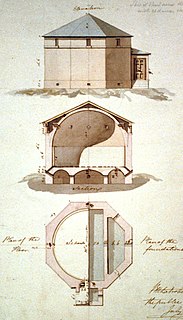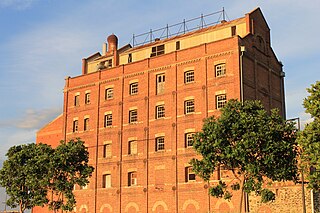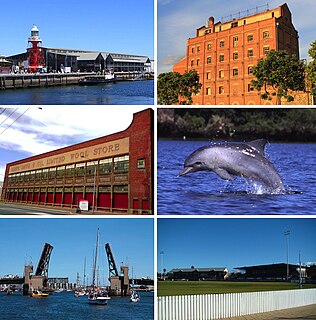
One Tree Hill is a town on the outskirts of Adelaide, South Australia. It is located in the City of Playford.

The City of Port Adelaide Enfield, located across inner north and north-western suburbs of Adelaide, is one of the largest metropolitan councils within South Australia. It was established on 26 March 1996 by the amalgamation of the City of Port Adelaide and the City of Enfield.

The River Torrens is the most significant river of the Adelaide Plains and was one of the reasons for the siting of the city of Adelaide, capital of South Australia. It flows 85 kilometres (53 mi) from its source in the Adelaide Hills near Mount Pleasant, across the Adelaide Plains, past the city centre and empties into Gulf St Vincent between Henley Beach South and West Beach. The upper stretches of the river and the reservoirs in its watershed supply a significant part of the city's water supply. The river's long linear parks and a constructed lake in the lower stretch are iconic of the city.

Port Adelaide station is located on the Outer Harbor line. Situated in the north-western Adelaide suburb of Alberton, it is 11.7 kilometres from Adelaide station.

The Port River is part of a tidal estuary located north of the Adelaide city centre in the Australian state of South Australia, and used as a shipping channel since the beginning of European settlement in 1836.

Alberton railway station is located on the Outer Harbor line. Situated in the north-western Adelaide suburb of Alberton, it is 10.2 kilometres from Adelaide station. The station is registered as a South Australian Heritage.
The Dry Creek to Port Adelaide railway is an eight-kilometre east–west line running through Adelaide’s north-western suburbs. The line is managed by the Australian Rail Track Corporation (ARTC) and is an important link between Port Adelaide, Pelican Point and the main interstate rail routes which link Adelaide with Melbourne, Perth, Darwin and Sydney. Prior to 1988, a limited local passenger service operated, stopping at five intermediate stations along the line. Since May 1988, the line has been freight-only.

Priddy's Hard is an area of Gosport, in Hampshire, England now being developed for housing with part of the site retained as a museum. However, for some two hundred years it was a restricted-access site; first becoming a fort and then an armaments depot for Royal Navy and British Army weapons, explosives and other stores.

Dry Creek is a mostly industrial suburb north of Adelaide, containing significant wetlands and a substantial area formerly devoted to salt crystallisation pans, managed by Ridley Corporation, which plans to redevelop the site for housing.
Gould Creek is an outer northeastern rural suburb of Adelaide, South Australia. Gould Creek is located in the City of Tea Tree Gully and City of Playford local government areas, and is adjacent to Greenwith, Salisbury Heights and Hillbank, as well as the rural districts of Yatala Vale and Upper Hermitage and the town of One Tree Hill.

A gunpowder magazine is a magazine (building) designed to store the explosive gunpowder in wooden barrels for safety. Gunpowder, until superseded, was a universal explosive used in the military and for civil engineering: both applications required storage magazines. Most magazines were purely functional and tended to be in remote and secure locations. They are the successor to the earlier powder towers and powder houses.
Torrens Bridge railway station was a short-lived railway station on the Outer Harbor line in North Adelaide. The location of the station was east of Bonython Park. It was located about 1.7 kilometres (1.1 mi) from Adelaide station.

The Truganina Explosives Reserve was a secure storage facility near Altona in the Australian state of Victoria. It was in operation from 1901 to 1962 to store mainly civilian explosives for mining and construction. The camp included several storage sheds and a jetty, which were connected by a narrow-gauge horse-drawn tramway. Like the Dry Creek explosives depot at Port Adelaide, the site is a testimony to history and transportation in Australia.

Hart's Mill is a former flour mill complex located on a bend in the Port River, in the north-western corner of Port Adelaide, South Australia. Now partially restored, it has become the suburb's cultural hub.
The District Council of Glanville was a local government area in South Australia from 1864 to 1888.

The Stuart O'Grady Bikeway is a 23 kilometres (14 mi) shared path in the northern suburbs of Adelaide, following the eastern side of the Max Fatchen Expressway. The northeastern end is adjacent to the on ramp from Two Wells Road to the Gawler Bypass Road. The southwestern end is adjacent to Port Wakefield Road. It is named after Stuart O'Grady.



















